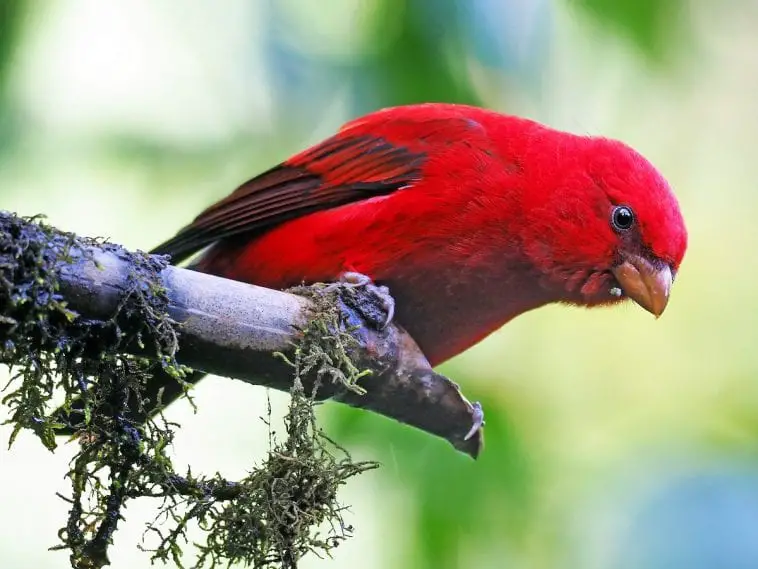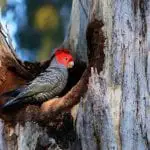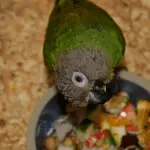Scientific Facts
| Scientific name: | Haematospiza sipahi |
| Rank: | Species |
| Higher classification: | Haematospiza |
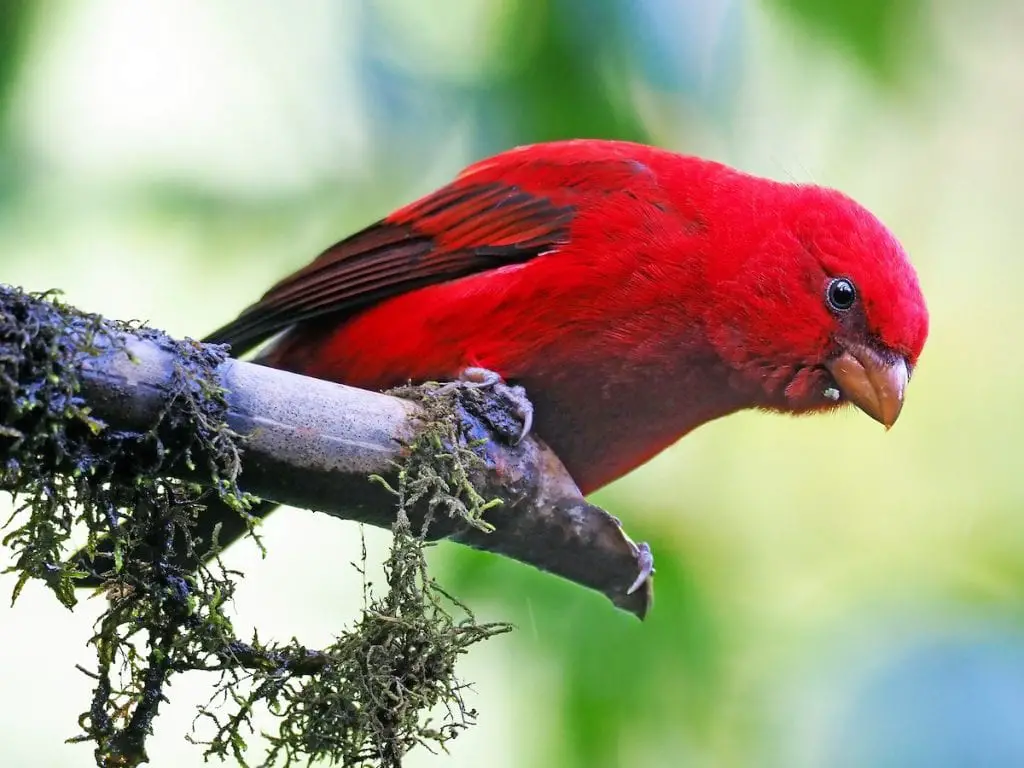
Description
The dazzlingly red male is appropriately named and unique. The female and young are cloudier, but still familiar with general greenish-yellow characters, a creamy rump, and a dense pinkish bill. Scarlet finches are likewise colored general; nonetheless, they have a lesser bill, a lengthier tail, and are more widely marked than the Rose Finch. Lives montane and hilly woods, where it typically changes around in small herds, often perching on bare twigs and snags. Gives rich indistinct notes.
Habitat
The Scarlet Finch is a species of finch in the Fringillidae family. It is found in the Himalayas from central Nepal eastwards to Vietnam and is found spottily in the adjacent hills of Northeast India and Southeast Asia as far south as Thailand. It is a resident in the Himalayas, but many birds winter to the immediate south. Its natural habitat is temperate forests.
Fun facts
Finch is a kind of songbird. Founded on the molecular examines, all finches are alienated in 4 subfamilies that cover more than 40 types. Finches can be found over and done with the world, excluding in Australia. They are particularly plentiful in the Northern hemisphere. Finches live deciduous and evergreen woods, tropical and subarctic parts, foothills, and deserts. Finches are general as pets since of their small scope and skill to produce lovely songs. A lot of finches are threatened due to home destruction, illnesses, and over-collecting from the desolate.
Finches can spread 3 to 6 inches in measurement and 0.35 to 1.2 ounces of weight.
Finch has brownish or greenish form enclosed with black, creamy, and red feathers. Males are further brightly colored than females.
Male house finch (kind of finch) has red-colored cranium and breasts. Red hue creates from the colors (carotenoids) from the nourishment that this bird is ingesting. Females favor mating with red males since red-colored cranium means that males can deliver suitable kind of food for their chicks.
Yellow-hue of the house finches cranium is a symbol of pressure or insufficient diet.
Finches can have a slight triangular beak, dense round beak, or beak with crisscrossed tips, contingent on the species and kind of régime.
Finches are herbivores (shrub eaters). Their food is grounded on numerous kinds of seed. Some type of finches eats sprouts and fruit.
Darwin planned its well-known philosophy of development by watching and probing finches on the Galapagos Islands. 14 types of Galapagos finches have mutual forebear that has arrived on Galapagos million years before. One kind of finch changed into 14 diverse types of birds as a consequence of version to dissimilar kinds of food and environments (all 14 types of Galapagos finches dwell different kinds of environments/islands). 14 species of Galapagos finches vary in the form and scope of their beak, body proportions, and performance.
Finches are inactive or partly traveling birds.
Finches are outgoing birds that frequently live in big flocks, also recognized as charms. They connect through numerous songs.
Finches build a basket-formed nest in the plants, scrubs, or the gaps of rocks.
Female rests 2 to 6 light blue eggs that hatch after a gestation period of 13 to 14 days.
Chicks are bare, blind, and stranded at birth. They stay in the layer throughout the initial 2 to 3 weeks of their lifetime.
Finches reach sexual adulthood at the stage of 9 to 12 months.
House finch is frequently kept as domesticated. This bird barely familiarizes the lifetime near humans besides caretakers should evade bodily contact with confined finch as much as conceivable. House finch needs the company of other finches to stay well both bodily and mentally.
Finches can live up to 20 years; nonetheless, most birds animate from 4 to 7 years in the barren.
Availability and where to get
You will be able to find such kind of bird from your specialized pet shop that caters to special kinds of birds. You can also get recommendations and referrals from your local bird breeders and vets.
Finches Are Very Communal Birds
All confined pet birds want some form of socialization to flourish in human households, and for numerous types, that comes with starting an unusual tie with their human caretakers. Finches, though, favor preparing things a little bit otherwise. Though there are exclusions to the instruction, at large, finches mainly favor the company of additional finches to that of a human friend. For this motive, it is usually suggested that they are kept in couples or small flocks, as opposed to being reserved singly. Birds who are held in reserve unaccompanied with no means of friendship often turn out to be unhealthy and emotionally and expressively unbalanced.
Finches Are Softbills—Perhaps
Completely parrots are classified as hookbills; consequently, it would make logic to categorize Finches as softbills — as a minimum, to some individuals it would! Calling Finches soft-billed birds is a contentious subject amongst numerous who are intensely complicated in aviculture. Many struggles that meanwhile Finches exist on large seed, in its place of insects and nectar, they must all be branded as waxbills or hardbills. Still, others declare that meanwhile, they are not hookbills, they are mechanically softbills. This discussion has been going on for numerous years, and for today, there doesn’t appear to be a conclusion in sight!
Finches Usually Don’t Like to Be Touched
Contrasting parrots, which must be touched every day, Finches incline to not do very fine with human treatment. Though there are continuously exclusions, it is usually optional that those who retain Finches touch them as slight as conceivable, to avoid terrifying the birds and instigating them pressure. While it is mutual for Finches to turn out to be familiar to observing their human housemates from a distance, maximum of them not ever quite get contented enough to roost on a person’s finger or be freely touched in any method. For your Finch’s wellbeing, keep handling restricted to what is essential for the bird’s wellbeing and medical maintenance.
Finches Are Amongst the Smallest Normally Reserved Pet Bird Species
Though there are numerous different kinds of small birds that are usually reserved as pets, Finches are amongst the least of them all! Most Finch type are less than 4 inches in measurement from the bill to the end of the tailfeathers besides might weigh below one ounce. Many would reason that this should brand them the faultless bird for minor, cozy households, but in certainty, a minor flock of Finches may need an even better cage than some kinds of parrots! This is for the reason that Finches must be able to hover; consequently, they need a roomy inclusion or flight birdcage that can permit them to fly and work out their wings.
Finches Are Very Silent
Though Finches express as much or further as other kinds of normally reserved pet birds, they have tiny singings that do not transmit as far as those of bigger birds, such as parrots. For this aim, Finches are an inordinate choice for bird devotees who live in rooms or condominiums. The enjoyable chips of a slight Finch flock can frequently not be caught outside of the area that the birds are contained in, nonetheless, several who own Finches privilege that their soft languages are quite calming, and select to devote as much time in the similar area with their birds as conceivable.
Common Diseases and Illnesses
HOUSE FINCH EYE DISEASE
Birds diseased with House Finch eye disease (likewise named Mycoplasmal conjunctivitis) have red, distended, gooey, or brittle eyes. In life-threatening cases, the eyes turned out to be inflamed shut, and the bird turns out to be blind. House Finch eye disease is instigated by the bacterium Mycoplasma gallisepticum. This bacterium has long remained recognized as a pathogen of native turkeys and chickens; nonetheless, it has been experimental in House Finches subsequently 1994. The illness has affected numerous other types, counting American Goldfinch, Evening Grosbeak, besides Purple Finch.
AVIAN POX
Two forms of avian pox exist. In the more common form, wart-like growths appear on the featherless areas of the body, such as around the eye, the base of the bill, and on the legs and feet. In the second form, plaques develop on the mucous membrane of the mouth, throat, trachea, and lungs, resulting in impaired breathing and difficulty feeding.
Avian pox can be instigated by numerous straining of the poxvirus besides has remained stated in at least 60 types of birds, counting turkeys, hawks, owls, besides sparrows. The disease can be spread by straight interaction with diseased birds or dirty surfaces (e.g., feeders) or by digestion of dirtied food or liquid.
SALMONELLOSIS
Salmonellosis is produced by microorganisms belonging to the type Salmonella. It is a common reason for death in feeder birds; nonetheless, the indications are not continuously clear. Sick birds may look thin or fat and bungled up and might have inflamed eyelids. They are frequently sluggish and easy to approach. Some diseased birds might show no external indications but are transporters of the illness and can spread the contagion to further birds.
Salmonellosis is chiefly conveyed by fecal infection of food and liquid by sick birds; however, it also can be conveyed by bird-to-bird interaction. Infrequently, epidemics of the illness cause noteworthy death in certain types counting Pine Siskin, Common Redpoll, and American Goldfinch.
Aspergillus
This is a fungal contagion, transported on by dank living settings and/or pressure. Diseased birds rapidly lose weight, and are rapid of breath. It’s an unusual disorder and proves deadly in maximum birds. A vet will offer medicine to kill the mold, and the finches’ living situations will require improving.
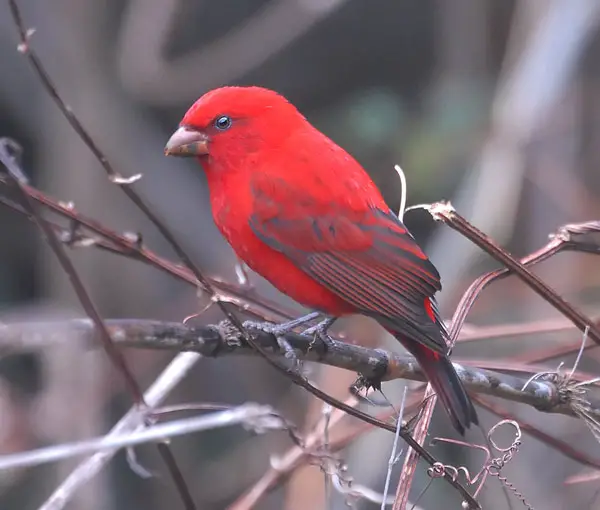
Avian Gastric Yeast (AGY) infection
Aka macrorhabdiosis, or megabacteriosis. AGY blooms in the birdie with no external mark of worry, and the primary thing you might see is weight loss, in spite of the finch ingestion with its typical enjoyment. Undigested nourishment in the mucks is an additional sign, or the bird may puke food and secretion. Sometimes microbes take benefit of the bird’s depressed immune system, producing a minor contagion called wasting illness, or “going light.” Medications can fight AGY, and the ill bird’s nourishment will need altering to omit all sugary nourishments. Inappropriately, AGY has a routine of lying unplanted and then flourishing over a few weeks far along.
Bumblefoot
This disorder reasons birds’ feet to swell and turn out to be distorted. It’s produced by a contagion typically related to dirty settling surfaces and branches. An over-fatty food and lack of workout can also inspire bumblefoot. A vet will recommend an ointment to fight the illness, but a similarly important medicine is too hygienic out the birdcage or aviary and supply heaps of natural-wood roosts that boost the birds to fly around and ‘travel with their toes.’ After an epidemic, it’s a good knowledge to sterilize all perches, grounds, and shelves.
Candidiasis
This is additional yeast contagion, produced by the Candida bacterium. It can bloom anyplace in a bird’s peptic system from the crop down. Some of the indications are comparable to AGY contagion – lethargy, sickness, and loose muck. The puke will have a foul smell, and the bird’s crop might swell up with yeast airs. In progressive cases, the finch will agonize loss of stability and trembling fits. A vet can manage medications to combat it. The treatment takes around one week, and all yeast-nourishing sugars (for example, those in fruits) should be provisionally omitted from the finch’s régime.
Chlamydia
This is a yeast contagion displaying as conjunctivitis and nasal emancipation. Diseased birds rarely die, and some display no indications but are carriers. A vet will recommend a medication that kills the yeast. There are additional conceivable yeast-borne contagions too, and keeping birdcages and aviaries unsoiled is half the fight against them.
Cloacitis
This is an irritation of the vent or cloaca. It inclines to disturb hens more than cocks. An inflamed stomach and sore-looking opening are the primary indications. The bird might likewise be constipated, and there might be tacky feces on the feathers about the vent. The problem is frequently diet connected or may happen after egg-laying. The bird will be required to be netted and prepared. A vet will occasionally endorse a zinc oxide cream for the sore part.
Conjunctivitis
This happens most often with the Canaries. The indications are crusty emancipation around the eyes, causing the eye completely in life-threatening cases. The eyes will be inflamed and sore-looking. In progressive contagions, the bird’s respiratory is affected as well, and demise soon follows. The reasons are diverse, including microorganisms, molds, nematode worms, or physical wounds. Your vet will recommend suitable action.
Care Sheet
Diet
Diet is very significant for keeping finches, as all you fodder them is only an auxiliary for what they would fodder themselves in the barren. A finch in its normal situation will be able to self-medicate itself for what it wants and complement itself with numerous food foundations, vitamins besides minerals. This is why it is significant that you offer a diverse diet to allow your finches to complement the diet consequently.
Seed- Fodder a good quality kernel mix. Nearly all finches have changed to fodder on one thing – grass kernels. This is why the mainstream of the seed mixture covers millet seed and canary seed. Since the seed is the foundation of their diet, it is significant to deliver a good class seed mix. Many individuals are of the confidence that all seed mixtures are similar; nonetheless, this couldn’t be more from the fact. Seed mix quality vagaries extremely, contingent on where it comes on or after, how new the seed is, and what kinds of seeds or fillers are used to brand up the assortment.
Greens – Seeding grasses, which are preferred for nearly all finches, though be cautious of grass that has been squirted with insecticides, as this can effortlessly kill a finch if expended. Additional greens, for example, endives, chickweed, dandelion, silverbeet besides kale, are good. Continuously rinse before nourishing birds.
Freshwater – the spirit of life continually makes certain they have fresh unsoiled water. If water is not kept new and fresh, your birds can turn out to be sick and, as a result, could die.
Significant instructions Keeping finches Strong
- Worm every single 3 months for outside birds and every single 6 months for indoor birds,
- Spray birds, layers and living accommodations with mite and lice sprig every 3 months
- medicate your birds with sulfa 3 or sulfadim every single 2 months for 3 days
- Medicate your birds with sulfa 3 or sulfadim throughout and after a heavy shower
Finch Compatibility with other birds.
Finches usually should not be contained with big parrots except they are in a huge birdcage where this can be completed conceivable as approximately zoo has done. Note that the more varied a gathering is, the larger the risk of finches of constricting diseases. Quails at the same time as being telluric are disposed to night scare as they get startled; they jump typically beating the roof of the birdcage, and all the inhabitants turn out to be startled as well; this can cause pressure and even demise in birds as they can effortlessly break there neck.
HOUSING HAZARDS AND CARE RULES FOR FINCHES
- Poisoning – take upkeep of toxins, substances, detergents, paints, etc.
- Empty vessels – dwindling in and choking.
- Filaments of string or cable – getting their feet wedged could consequence in death.
- Excited families – Finches can be slain with love, as joyful kids playing with them too extended, particularly if the finch is not used to the novel setting, can consequence in pressure and then death.
- Barbs in aviary or birdcage – can outcome in the wound.
- Open lavatories or bodies of water. If they tumble in, they can die.
- Killers, for example, snakes, rats, besides butcher birds – these will consume your birds, so conceal the mainstream of the birdcage if it is left outdoor, so finches have a defense.
- Cold – retain finches away from breezes, source heating, or shelters for finches reserved in cold weathers or wintertime. If a finch gets freezing, it can effortlessly turn out to be sick and die. Dissimilar types are more lenient of cold than others.
- Moving finches – This can be very demanding and reason finches to get the innings/diarrhea, which in some cases can principal to disease. So, if you buy or move finches, it is optional to dosage them with sulfa 3 or Sulphadim, which is a very slight antibiotic and halts finches from getting the innings. This drives in the drink and must be completed 5 days after stirring to a new birdcage and site.
- Diseases, pathogens, and microbes – clean birdcage or aviary with bird responsive antiseptic, which is obtainable at Birdsville
- Windows – becoming wedged and finally death happens
- Flying away
- Candles – getting seared
- Hard grounds – Birds that are not skilled flyers mooring on the ground and staining their chest, which can rapidly consequence in illness and death.
- Weekly – give a detailed scrubbing to the birdcage or aviary.
- Day-to-day – stock with freshwater and kernel in clean vessels.
- Monthly – check birdcage for hovels, rat holes.
- Monthly – unsoiled or change twigs, clean out nesting containers after the young have left the layer.
Note, please, every single 3 to 6 months worm your birds.
FAQ Section
Do finches need to be enclosed in the evening?
Finches are eventful little birds and appear to enjoy hovering from one layer to another. If a bird is reserved in a busy portion of the home, even if the birdcage is enclosed in the evening, if the TV or computer is still on the bird will not obtain the correct relaxation that it needs to uphold good wellbeing.
Do finches prefer to be held?
Though finches cannot be controlled fairly like parrots, finches are sufficient for amusing to attend to and watch. They come in a diversity of spectacular colors and make quiet sounds that many find enjoyable.
What do you fodder a finch bird?
Finches are usually seedeaters and eat a diversity of plant kernels, particularly grasses. Since period commands seed obtainability, there are periods of the year when insects and certain pods, berries, and shrubbery will establish the majority of the diet.

